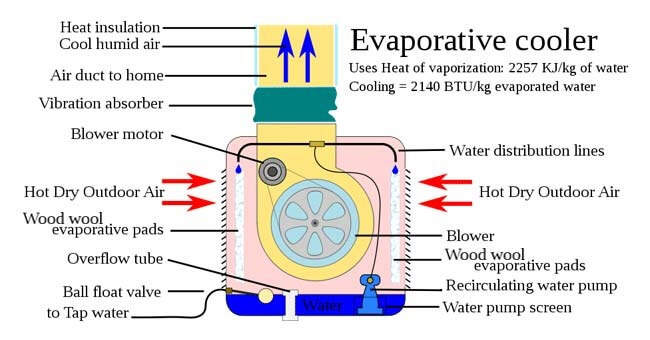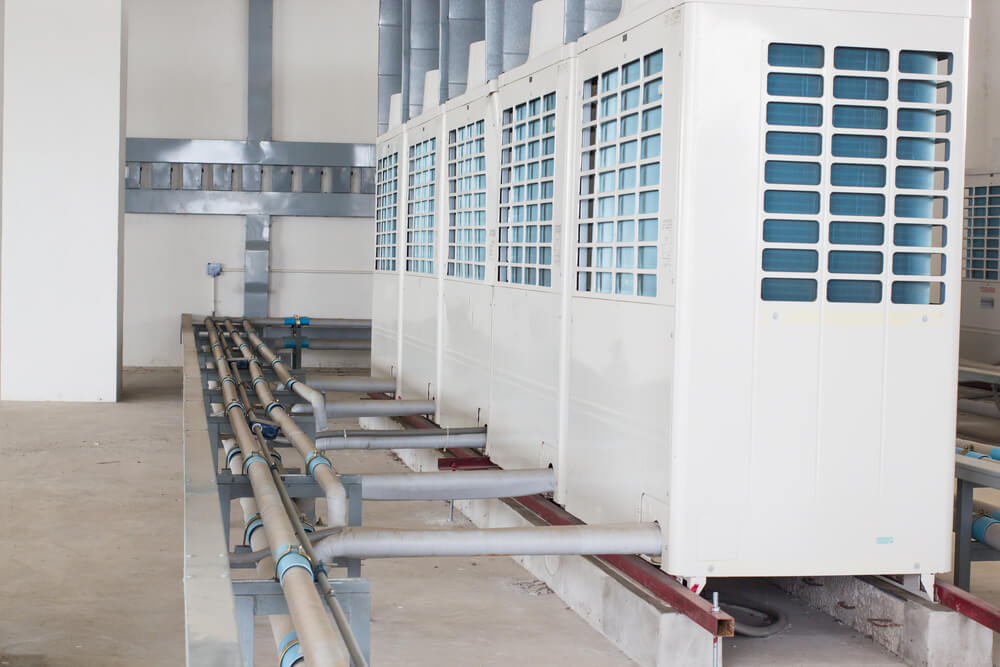What is an Evaporative Cooler?
An evaporative cooler, also known as a swamp cooler, consists of a fan that draws warm air through water-saturated pads or filters. As the warm air passes through these moist pads, the water evaporates, extracting heat from the air and causing the air temperature to drop. The cooled air is then circulated into the living space.
It operates on the principle that when water evaporates, it absorbs heat from the surrounding air, thereby cooling it down. They are generally more energy-efficient and environmentally friendly compared to traditional air conditioning systems that use refrigerants to cool the air.
Types of Evaporative Coolers
There are different types of swamp coolers. Some fixed units blast air directly into the building, while others use duct systems to distribute air to numerous areas; some fixed units are moveable, while others must be anchored to the wall. Evaporative air cooler ducts, on the other hand, are frequently larger than conventional ducts, and using the incorrect duct system will reduce the performance of your air cooler. Knowing the circumstances of your home or business can help you choose the right cooler.
Evaporative air coolers come in three varieties:
- Direct swamp coolers
- Indirect swamp coolers
- Mounted “draft” swamp coolers
Direct Evaporative Air Coolers

These machines, often known as swamp coolers, are undoubtedly the most cost-effective temperature control method. They’re cheap to run, need little upkeep, and are generally portable enough to take wherever you choose. There’s also no need for setup: they’re ready to use right out of the box; plug them in and fill the reservoir with water.
On a hot, dry day, these devices employ the natural cooling qualities of water vapor to reduce the air temperature in your shop by as much as 26°F. Warm air from the outside enters the evaporative media pad, where it is trapped; as waterfalls through the pad, air molecules are cooled by evaporation. A substantial 30″ diameter fan pushes wet (but still dry) air across the industrial space.
Also Read: Evaporative Cooling Vs Refrigerated Cooling
Indirect Evaporative Air Coolers
Because they don’t add humidity to the air, these coolers don’t swamp coolers. They aren’t even transportable. Indirect cooling, on the other hand, allows industrial buildings, restaurants, and other companies to chill their areas at lower temperatures than portable swamp coolers like the Cool Boss.
One thing that all evaporative coolers have in common is that the hotter the outside air is, the better the device functions. Indirect coolers make use of a secondary air source that can be heated before entering the evaporative media pad. Simply put, two air sources can be mixed, heated, and chilled through one or two stages of evaporation.
Mounted Coolers

Direct and indirect coolers share several characteristics. Direct air coolers can be mounted or portable, whereas indirect air coolers must be mounted. An evaporative air cooler can be installed on the floor, a windowsill, or the roof.
Ground-mounting
The least frequent way for placing air coolers is ground-mounting; because cold air falls and hot air rises, there is less circulation of cool air if it is created close to the ground.
Window-mounting
For smaller rooms and work areas, window mounting is a common choice. A window-mounted air cooler will always have access to a source of fresh air.
Roof-mounting
Roof-mounted evaporative air coolers are prevalent in commercial and industrial settings, but not in most individual homes. Air ducts are required for these units, and they are more likely to require costly maintenance over time. However, installation is simple, especially if the building already has the necessary air ducts.
Air coolers are far less expensive to run than air conditioners, whether you’re searching for a portable evaporative air cooler (also known as a swamp cooler) or a more permanent alternative.
Also Read: Swamp Cooler vs Air Conditioner
Common FAQs About Types of Evaporative Coolers
What is the difference between a swamp cooler and an evaporative cooler?
There is no difference between these two terms.
What is the best type of evaporative cooler?
Direct portable evaporative coolers are often considered best for efficiency, simplicity, and easy installation in smaller spaces.
What are the drawbacks of evaporative cooling?
The disadvantages of evaporative cooling are few. Although an evaporative cooler requires minimal maintenance, there can be a buildup of salts and mineral deposits if your area has hard water. Moreover, maintenance of evaporative coolers can be a lot more inconvenient and possibly dangerous if the cooler is located on the roof.
Can you put ice cubes in an evaporative cooler?
Ultimately, it is up to you whether you put ice in your evaporative cooler. Most likely it won’t hurt anything – we say most likely because theoretically your pump could suck up a piece and seize up. You have to weigh if you think it is worth a 2°F temperature difference over 30 minutes.
Do evaporative coolers need to be vented?
Evaporative coolers don’t require venting like portable ACs, but the air forced out will still require an exit path to ensure sufficient cooling (this can usually be accomplished with an open door or window)
Is it cheaper to run a swamp cooler or air conditioner?
Swamp coolers are far more energy-efficient for home cooling. Swamp coolers will use 15% to 35% of the energy used by most traditional AC units. They also do not require any chemicals in the way that traditional AC does
How to prevent calcium buildup in swamp cooler?
To prevent calcium buildup in a swamp cooler, regularly clean the unit’s water distribution system. Use a descaling agent or vinegar solution to remove mineral deposits. Additionally, consider installing a water softener or using distilled water to minimize mineral buildup and ensure proper maintenance of the cooler. Regular cleaning and preventative measures can help mitigate calcium deposits, maintaining the efficiency of the swamp cooler.
How to remove calcium deposits from swamp cooler pads?
Soak swamp cooler pads in a mixture of vinegar and water or a commercial descaling solution to dissolve calcium deposits. Rinse thoroughly and let pads dry before reinstalling for optimal performance.

